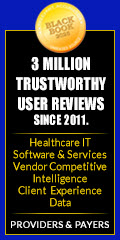Regarding Medstar - I have to wonder how many decisions were made to go to Cerner over Epic based on…
Monday Morning Update 11/24/08
From Fourth Hansen Brother: "Re: big time Philips layoffs." Link. Philips will cut 1,600 jobs in its healthcare unit, along with raising prices and cutting other expenses. The North Andover, MA headquarters will get hit with100 layoffs.
From Aries Ram: "Re: Intel. Heard at the mid-year ATA show there was a small demo of Intel’s new home monitor. Comments were not endorsing, primarily based upon how data was displayed. Also, they had a slow booth at NAHC. Philips was busy … and picking up additional customers after Intel’s recall of acquired product.It isn’t always about the bells and whistles. Get the users to weigh in on the product."
From Alias Unknown: "Re: The MedicalPhone. The MedicalPhone website was down for a day or two earlier this week after they received press mentions. Glad to see it’s back up." Here’s the link again.
I’m tired of gloom and doom news. Let’s hear more about positive company developments and maybe something about the charitable causes companies will support during the holidays. On the business front, EnovateIT e-mailed over its list of 2008 accomplishments: gross sales up 35%, headcount doubled, square footage expanded eightfold, and new customers and products. Anyone else?
The Wall Street Journal investigates questionable practices in UPMC’s liver transplant program and the shady transplant surgeon it brought in and later fired, but casts the net wider. "UPMC is a nonprofit hospital system whose income is largely exempt from taxes. Yet, it is increasingly run like a for-profit company, paying its executives high salaries, jumping into new activities and expanding abroad … Its chief executive, Jeffrey Romoff, earned $4 million in the fiscal year ended June 30, 2007, and 13 other employees earned in the roughly $1 million to $2 million range. For their transportation, UPMC leases a corporate jet. Earlier this year, UPMC relocated its headquarters into Pittsburgh’s tallest skyscraper, the 62-story U.S. Steel Tower."
Brigham and Women’s is using IVR/speech recognition technology from Vocantas to collect information from patients who have started new drug therapy. The company has developed applications for discharge follow-up, disease management, and running emergency call lists.
Stratus Technologies is offering a free, one-hour Webinar on December 10th at 1:00 Eastern on A Failsafe Cure for Healthcare IT Headaches – Virtualizing for Total Availability.
McKesson will pay $350 million to settle all private claims involving alleged drug price rigging (with the alleged complicity of First DataBank) through manipulation of published average wholesale prices, filed under the Racketeer Influenced and Corrupt Organization Act. They got off light considering earlier estimates of $15 billion.
The Project Valour-IT fundraising challenge will wind down this week, ending on Thanksgiving Day. You can donate here to help cover the cost of a several wounded military member’s rehabilitative technology. The $54,532 raised so far is a long way from the $250,000 needed. Thanks.
I wrote Thursday about nurses in the UK using cell phone software to monitor data entered by chronic patients at home. The celebration was premature, as it turns out: the hospitals using the t+ Medical software have ditched it already, saying it was too cumbersome to put into practice.
Picis offers a free report on business intelligence tools.
I don’t have the courage to look at my 401K or IRA balances, but I figured it was time to check out HIT stock prices over the past six months since I don’t hold those:
- Google: down 58%
- Siemens: down 55%
- GE: down 54%
- QuadraMed: down 51%
- Allscripts: down 51%
- McKesson: down 46%
- Cardinal Health: down 45%
- NASDAQ Composite: down 44%
- Dow Jones Industrial Average: down 36%
- Eclipsys: down 36%
- Cerner: down 30%
- Microsoft: down 30%
- Perot Systems: down 25%
- Athenahealth: down 23%
- HP: down 22%
- Quality Systems: down 9%
- CPSI: up 27%
Landmark Medical Center (RI) is operating under a court-ordered supervisor and seeking a buyer. Among other examples of bad healthcare conditions, the article mentions that 10 of New Jersey’s 80 hospitals have shut down in the last two years.
It appears that Oklahoma State University Medical Center is on the brink of closing or selling out to St. John Medical Center, with its Web site turned into a plea for state government help. It might be the only hospital Web site in existence that doesn’t say where the hospital is (Tulsa) or how to contact it.
The Social Security Administration wants to develop a system that can extract medical records information for disability claimants from EMR systems using the Continuity of Care Document format. It’s being piloted now at BIDMC and Cleveland Clinic.
An argument between Muskogee Regional Medical Center (OK) and local surgeons goes to the state’s Supreme Court. The hospital insists that two surgeons must be on ED call for 192 hours per month, based on its bylaws that require around-the-clock coverage. The doctors say the hospital gets federal money for ED coverage and should hire its own.
Vendor Deals and Announcements
- Parkland Health & Hospital System (TX) implements Innovation’s PharmASSIST pharmacy automation systems across its nine pharmacy sites. PharmASSIST is integrated with the Cerner PharmNet system to process 6,000 prescriptions a day.
- SecureCare Technologies’ Sfax solution is now integrated into Addison Health Systems’ WritePad EMR.
- Interactive patient care system provider Skylight Healthcare Systems signs an agreement to deploy Skylight ACCESS for Cancer Treatment Centers of America’s new facility at Western Regional Medical Center.
- Edward Hospital and Health Services (IL) will implement Allscripts’ Enterprise EHR/PM solution for 50+ providers. Another 40 providers will use just the Allscripts’ PM solution.
- Centegra Health Systems (IL) signs a long term service agreement with Perot to provide support for its IT platform and assistance implementing a clinical system and other technologies.
- Brigham and Women’s Hospital (MA) will use Vocantas’ CallAssure interactive voice response system to study the effectiveness of using automated telephone follow-up systems to manage chronically ill patients using commonly prescribed medications.
- Former Cerner sales leader Mike Fiorito is named the new chief sales and marketing office for LifeWatch Services.
- Children’s Health System (AL) will deploy Eclipsys’ Sunrise solutions at its new $500 million facility opening in 2012.
- Acesis announces the release of Clinical Product Review Suite, a new product designed to automate the peer review process for hospitals and other healthcare providers.
- Harold Miller is named president and CEO of the Network for Regional Healthcare Improvement.
- Twelve critical access hospitals in North Dakota launch a pilot program focused on improving patient safety through automated and shared data collection. The Critical Access Hospital Quality Network with use Clarity Group’s Healthcare SafteyZone Portal.
- Western Missouri Medical Center completes installation of DR Systems’ PACS solution.
- Rodney Schutt is named Asprya’s new CEO, having previously been with Luminetx, Smith and Nephew Orthopaedics, and GE Healthcare.
- Seattle Children’s Hospital selects DatStat to provide its staff tools to improve enterprise research and to facilitate feedback from employees, patients, and patients’ families.
- Wexford-Mercy PHO (MI) selects WellCentive Registry to help improve clinical quality outcomes and streamline the care delivery process.
- BCBS of Vermont says it has saved almost $500K using VUE Compensation Management’s compensation management technology.
- Orthopedic Associates of Meadville (OH) selects SRS’s EMR solution for its five-physician practice.
- Daniel Kohl is named the new president and CEO of clinical documentation service provider Spheris.
- Bert Fish Medical Center (FL) selects Xceedium’s GateKeeper technology to provide secure remote administration services.
- Mediware Information Systems acquires the assets of pharmacy management software provider Hann’s On Software (HOS). The purchase, which includes $3.5 million in cash plus potential operational performance monies, adds 320 pharmacy facilities to Mediware’s client base.
- dbMotion is named winner of the Healthcare IT Summit’s Innovation Award in the Best Case Study Presentation category. The winning presentation focused on dbMotion’s implementation at UPMC.
- Healthvision solutions is a new reseller for MediSolution’s Virtuo BI solutions.
- The Defense Health Information Management Systems Program selects Base Technologies to provide teleradiology support services for Medweb’s PACS solution in war zones.
- CCHIT announces three new members to its board of trustees. Meighan Girgus, EVP for the American Heart Association; Wes Rishel, VP for Gartner; and Dr. Bruce Taffel, VP/CMO for Shared Health. They will serve staggered, three-year terms.
- Lynn Hudson, national EMR product manager for HealthPort,is a new member of The Electronic Health Records Association Executive Committee.






















































































>>> I’m tired of gloom and doom news. Let’s hear more about positive company developments… Anyone else?
Although there are 3 CCHIT-certified EMRs that have gone belly-up, I may actually retire temporarily my “CCHIT Hall of Fame” which tracks doom-and-gloom CCHIT certified EMR companies as several EMR companies on my list are actually doing quite well, s.a. former graduates including NextGen, Greenway, AthenaHealth, Cerner and CPSI all of which had some issues in pre- and early 2008 (some including stock devaluations of 30% or more) but which have shown strong positive growth after the summer, even in the middle of our recession.
Disclaimer: That said, as a physician who has a heavy personal interest in HIT, I’d prefer to see these big companies suffer, as it makes it less likely that the government and third parties will force us docs to purchase EMRs for worthless projects like P4P and e-prescribing, which is wrong.
Al
Had a chance to get a demo of the new Intel Health Guide product and concur with the comments above. Some nice features such as the embedded video cam for live streaming. But he product really falls down when it comes to data management and presentation. Doubt many caregivers will want reams of data coming into them as simple columns of values.
As for HIT stocks, well Mr. HIStalk, that is quite a broad net you cast there, Google?
For doctors such as Al above, one small bit of advice. Starting using these HIT tools now and get familiar with them as customers will increasingly expect such from you in your day-to-day practice. And no, stop waiting around for some govt. handout and why not invest a little.
>>> Starting using these HIT tools now and get familiar with them as customers will increasingly expect such from you in your day-to-day practice.
Actually, most of my patients are gardeners, maids, cooks, etc, none of which have asked me to buy a CCHIT-certified EMR. Many docs already have investments in non-CCHIT certified EMRs, all of which seem to be doing quite well if you look at the recent biennial 10/2007 report which showed that although expensive “EHRs” (synonymous with CCHIT-certified EMRs) have not significantly grown from 2005-2007, cheaper EMRs in general have grown in a rather robust manner. P4P programs threaten to force them to disinvest from their current EMRs.
I personally will be affected- I program and have a great EMR/PMS (with an oncology subprogram) that rocks. If they force me to disinvest, well, I’d be rather upset. To that end, I spent the past 2 years riling the masses against these mostly political intrusions into healthcare, and this summer I started a free website to teach other docs on programming their own EMRs. The future of HIT the 75% of docs that are in solo and small office setting is in the inexpensive and open source EMRs!
Al
John – I believe Al was referring to government mandates that would force him to purchase (government approved) software, also known as government intervention in a “free” market.
Al has the right idea, but if I may add: the larger companies are larger for a reason. In a truly free market, it would be due to the superiority of their products and efficiency of operations. In our less-than-free market, there is also likely some fraud (Siemens?) and government favoritism at work. While they are commended for their performance in these times, we should be rooting for the smaller companies which will find it more and more difficult to survive in this ongoing economic correction. Businesses do not, in fact, like competition, and if you doubt that, please review early 20th century history. Can you imagine the HIT arena with only Cerner, Epic, and GE? It wouldn’t take long – especially after universal EMR adoption – for them to argue that they are “too big to fail,” and be lined up in DC looking for handouts.
That said, in the interest of the free market, there should be no intervention into any market. Companies will go under, jobs will be lost, but enterprising individuals will create new products and opportunities.
Excellent, Wompa1!
What I’ve never understood was why did HIMSS/EHRA ever bother to put together CCHIT in the first place when the bad press was sure to hurt the HIT market, at least temporarily. Government regulation has never been the way to win over customers, and in fact, physicians have always very recalcitrant to being pushed into anything.
I don’t think that there exists a blog on the ‘net that is pro-CCHIT nowadays. That wasn’t the case back in 2006. I remember writing about 2500 blog posts in emrupdate alone and over 100 letters to various Congressmen and to the the likes of FTC arguing that CCHIT is really not a good thing. Nothing ever came from the letter writing campaign. I did find that CCHIT had made a small error in their incorporation papers in which they discussed redistributing their 2006 profits (see http://msofficeemrproject.com/Page3.htm ). They eventually had to reincorporate, where I supposed they fixed that (their transparency doesn’t include posting their minutes in a detailed manner or incorporation papers anymore). The blog onslaught, though, did change public opinion on CCHIT… folks now realize that this organization is less a “certification” and more a free market manipulation group. That’s good!
When CCHIT is finally marginalized, you’ll see that physicians will buy “enterprise” EHRs for what they really offer once again. There are a lot of docs that still don’t have HIT. EHRs will need to support dictation, free text, and typing- i.e. make an EMR what to have those elements that buyers really want, not third party “standards”. No CPOE? Fine. Less granularity? Great! Less features, “lite” version? No problem. I really look forward to that day…
Al
Al,
Face it, you have the most expensive application on the market. Your support and research and development comes from a physician, you, with either too much time on his hands or one that is seeing has to fewer patients to tinker with an EMR application. Either way it is your call, but not every physician has the time, skills or inclination to do it themselves.
No market is perfect, at least that I am aware of. In healthcare, find it particularly challenging as you not only have the base issue of technology, you layer that with a tradition-bound set of practices that date to the mid 19th century, some even earlier, government regulations, numerous stakeholders and a highly fragmented market. Some real challenges here if you are a vendor trying to take a product to market, or a buyer trying to ascertain what is best for their facility/practice.
In my initial comment, referenced what I perceived as reluctance on Al’s part o adopt HIT and only adopt it if someone was willing to foot the entire bill. This attitude, which I have found pervasive in this market is demented.
However, if Al was simply referring to the future where in P4P programs would only be supported if the practice was using a CCHIT-certified EMR, well that is just plain silly and am in full agreement with Al.
As for why did various parties support the formation of CCHIT, that is really quite simple – Control. Those parties saw the writing on the wall – HHS/ONCHIT were goin to put a certification process in place. Therefore, instead of waiting for the govt to push something unpalatable upon them, usurp the process by becoming a part of it, directing its outcome(s) in favor of major sponsors etc.
>>> Face it, you have the most expensive application on the market…
You’re probably right, but I love to program- it’s time off from seeing patient complaints and it makes me feel like Pavarotti leading a VBA orchestra. A good sized minority of docs program too- just check out the growth of my website in its first 5 months dedicated to making the perfect MS Office EMR ( http://i38.photobucket.com/albums/e103/alborgmd/Miscellaneous/websitegrowth.png ).
So there is interest. Some of the programming knowledge can be used to augment a traditional vendor-supplied EMR too.
Al
Please tell more about the t+ medical situation. Is this company viable or just having too many issues???
Regarding inaccurate comments about “hospitals dropping t+” infact one secondary care general hospital did not proceed to a full implementation two years ago as the nurses in the hospital were unwilling to log on to the website to manage patients. Now the t+ system incorporates an inhouse nurse call centre to combat this specific issue and is much more suited to primary care and avoidance of acure admissions / reduction of costs. Uniquely these have been proven in a collection of 20 validatory clinical trials in areas as diverse as Oncology, Cystic Fibrosis, COPD, Diabetes, Drug Titration and Asthma.
In reality the use of any telemetry based system is most effectively utilised as primary care triage not acute management. We believe we are one of the most widely deployed systems in the world with patients in Singapore, Dubai, France, Egypt, UK and US and currently have 24 centres in the UK and several in the US through partners like J&J using the system and literally thousands of patients managed every day. One pilot out of 24 not proceeding to full implementation is not a phenomenal success rate and does not deserve the loose comments expressed on this blog.
I would invite Patient101 to contact me directly through the T+ website at info@tplusmedical.com if they are seeking any assurances about our viability. Better still try the system – as many leading organisations have. Also watch the press in the next two weeks for details of a major new player in this market who have done substantial due diligence of every current player and chosen T+ as their launch technology.
If anyone is interested in low cost, high volume, super scalable telemedicine on the world’s most accessible data infrastructure then give T+ a call.
Tim Clover
CEO – T+ Medical.